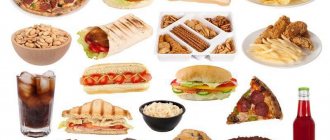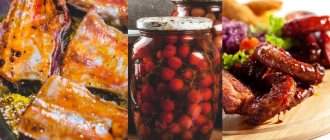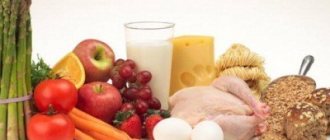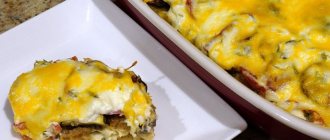General rules
Diet No. 15, Table No. 15 according to Pevzner is prescribed for diseases that do not require special therapeutic nutrition in the absence of disorders of the digestive system.
This is a transitional diet from any therapeutic to regular nutrition during the recovery period. Refers to physiologically complete nutrition in a hospital setting and corresponds to nutritional standards for a person who does not engage in physical labor. It is also called the general diet.
It contains a sufficient amount of nutrients, minerals and an increased amount of vitamins . The diet does not provide for any sparing of the gastrointestinal mucosa; the range of products is varied. Dishes have a variety of heat treatments (even frying).
Chemical composition: 90-95 g of proteins (half of animal origin), 100 g of fat (one third of vegetable origin), 350-400 g of carbohydrates. Energy value - 2600-2700 kcal. Salt is allowed in the amount of 12 g, and liquid - 1.5-2 liters. Diet plays an important role. You should not allow long breaks and eat food at least 4 times (more is possible when organizing light snacks). Fractional meals at certain hours contribute to the rhythmic activity of the gastrointestinal tract.
Chemical composition and energy value of dietary table No. 15
Proteins: 85–90 g (including approximately 45% animal proteins). Fats: 70–80 g (including at least 30 g of vegetable fats). Carbohydrates: 300–350 g (including up to 100 g of simple sugars). Daily calorie content: 2,200 – 2,400 kcal. Free liquid: 1.5–2 l. Table salt: 8–10 g Vitamins: retinol (A) – 1 mg, riboflavin (B2) – 2.8 mg, thiamine (B1) – 2.4 mg, nicotinic acid (B3) – 20 mg, ascorbic acid ( C) – 150 mg. Macroelements: sodium – 5 g, potassium – 4.3 g, calcium – 1.3 g, phosphorus – 2.2 g, magnesium – 0.6 g. Microelements: iron – 40 mg. Optimal food temperature: no restrictions.
Authorized Products
Dietary Table number 15 includes:
- Wheat and rye bread, any flour products.
- It is better to cook soups with weak and non-greasy broths. This can be borscht, cabbage soup, rassolnik, beetroot soup, vegetable, cereal and mushroom soups, as well as dairy soups.
- Any fish and different culinary preparations.
- Low-fat meat and poultry are prepared in any way. Boiled sausages, frankfurters, and small sausages are allowed.
- Fermented milk drinks (yogurt, kefir, yogurt, acidophilus) are required in the diet.
- It is necessary to include milk, cottage cheese, cheese, sour cream (it is added to dishes) daily.
- Eggs in any preparation.
- Various cereals, pasta and legumes if well tolerated.
- Butter, ghee, vegetable oils.
- Any vegetables (limited to radishes, radishes), greens.
- Fresh fruits and berries, raw and after heat treatment (purees, mousses, jellies), fresh juices, compotes, jelly, fruit drinks.
- Recommended drinks include: cocoa, tea, coffee, rosehip infusion and wheat bran decoction.
- Sugar, jam, jam, honey, ice cream, marmalade are allowed.
Table of permitted products
| Proteins, g | Fats, g | Carbohydrates, g | Calories, kcal | |
Vegetables and greens | ||||
| zucchini | 0,6 | 0,3 | 4,6 | 24 |
| cabbage | 1,8 | 0,1 | 4,7 | 27 |
| cauliflower | 2,5 | 0,3 | 5,4 | 30 |
| carrot | 1,3 | 0,1 | 6,9 | 32 |
| cucumbers | 0,8 | 0,1 | 2,8 | 15 |
| beet | 1,5 | 0,1 | 8,8 | 40 |
| pumpkin | 1,3 | 0,3 | 7,7 | 28 |
Fruits | ||||
| apricots | 0,9 | 0,1 | 10,8 | 41 |
| oranges | 0,9 | 0,2 | 8,1 | 36 |
| watermelon | 0,6 | 0,1 | 5,8 | 25 |
| bananas | 1,5 | 0,2 | 21,8 | 95 |
| pears | 0,4 | 0,3 | 10,9 | 42 |
| melon | 0,6 | 0,3 | 7,4 | 33 |
| lime | 0,9 | 0,1 | 3,0 | 16 |
| lemons | 0,9 | 0,1 | 3,0 | 16 |
| tangerines | 0,8 | 0,2 | 7,5 | 33 |
| plums | 0,8 | 0,3 | 9,6 | 42 |
| apples | 0,4 | 0,4 | 9,8 | 47 |
Berries | ||||
| grape | 0,6 | 0,2 | 16,8 | 65 |
| strawberry | 0,8 | 0,4 | 7,5 | 41 |
| sea buckthorn | 1,2 | 5,4 | 5,7 | 82 |
| currant | 1,0 | 0,4 | 7,5 | 43 |
| rose hip | 1,6 | 0,0 | 14,0 | 51 |
Mushrooms | ||||
| mushrooms | 3,5 | 2,0 | 2,5 | 30 |
Nuts and dried fruits | ||||
| raisin | 2,9 | 0,6 | 66,0 | 264 |
| dates | 2,5 | 0,5 | 69,2 | 274 |
Cereals and porridges | ||||
| buckwheat (kernel) | 12,6 | 3,3 | 62,1 | 313 |
| cereals | 11,9 | 7,2 | 69,3 | 366 |
| corn grits | 8,3 | 1,2 | 75,0 | 337 |
| pearl barley | 9,3 | 1,1 | 73,7 | 320 |
| millet cereal | 11,5 | 3,3 | 69,3 | 348 |
| white rice | 6,7 | 0,7 | 78,9 | 344 |
| barley grits | 10,4 | 1,3 | 66,3 | 324 |
Bakery products | ||||
| bagels | 16,0 | 1,0 | 70,0 | 336 |
| buns | 7,2 | 6,2 | 51,0 | 317 |
| butter horns | 8,3 | 12,1 | 50,5 | 345 |
| drying poppy seeds | 11,3 | 4,4 | 70,5 | 372 |
| wheat bread | 8,1 | 1,0 | 48,8 | 242 |
| rye-wheat bread | 8,1 | 3,4 | 42,2 | 222 |
| Rye bread | 6,6 | 1,2 | 34,2 | 165 |
Confectionery | ||||
| jam | 0,3 | 0,2 | 63,0 | 263 |
| jam | 0,3 | 0,1 | 56,0 | 238 |
| jelly | 2,7 | 0,0 | 17,9 | 79 |
| fruit and berry marmalade | 0,4 | 0,0 | 76,6 | 293 |
| Kurabye cookies | 6,7 | 25,8 | 64,6 | 516 |
| oatmeal cookies | 6,5 | 14,4 | 71,8 | 437 |
| cake | 3,8 | 22,6 | 47,0 | 397 |
Raw materials and seasonings | ||||
| honey | 0,8 | 0,0 | 81,5 | 329 |
| sugar | 0,0 | 0,0 | 99,7 | 398 |
| milk sauce | 2,0 | 7,1 | 5,2 | 84 |
| sour cream sauce | 1,9 | 5,7 | 5,2 | 78 |
Dairy | ||||
| milk | 3,2 | 3,6 | 4,8 | 64 |
| kefir | 3,4 | 2,0 | 4,7 | 51 |
| cream | 2,8 | 20,0 | 3,7 | 205 |
| sour cream | 2,8 | 20,0 | 3,2 | 206 |
| curdled milk | 2,9 | 2,5 | 4,1 | 53 |
| acidophilus | 2,8 | 3,2 | 3,8 | 57 |
| yogurt | 4,3 | 2,0 | 6,2 | 60 |
Cheeses and cottage cheese | ||||
| cheese | 24,1 | 29,5 | 0,3 | 363 |
| cottage cheese | 17,2 | 5,0 | 1,8 | 121 |
Meat products | ||||
| beef | 18,9 | 19,4 | 0,0 | 187 |
| veal | 19,7 | 1,2 | 0,0 | 90 |
| rabbit | 21,0 | 8,0 | 0,0 | 156 |
Bird | ||||
| chicken | 16,0 | 14,0 | 0,0 | 190 |
| turkey | 19,2 | 0,7 | 0,0 | 84 |
Eggs | ||||
| chicken eggs | 12,7 | 10,9 | 0,7 | 157 |
Fish and seafood | ||||
| Red caviar | 32,0 | 15,0 | 0,0 | 263 |
| black caviar | 28,0 | 9,7 | 0,0 | 203 |
| canned fish | 17,5 | 2,0 | 0,0 | 88 |
Oils and fats | ||||
| butter | 0,5 | 82,5 | 0,8 | 748 |
| corn oil | 0,0 | 99,9 | 0,0 | 899 |
| olive oil | 0,0 | 99,8 | 0,0 | 898 |
| sunflower oil | 0,0 | 99,9 | 0,0 | 899 |
| ghee | 0,2 | 99,0 | 0,0 | 892 |
Non-alcoholic drinks | ||||
| mineral water | 0,0 | 0,0 | 0,0 | — |
| lingonberry juice | 0,1 | 0,0 | 10,7 | 41 |
| green tea | 0,0 | 0,0 | 0,0 | — |
| black tea | 20,0 | 5,1 | 6,9 | 152 |
Juices and compotes | ||||
| compote | 0,5 | 0,0 | 19,5 | 81 |
| apricot juice | 0,9 | 0,1 | 9,0 | 38 |
| jelly | 0,2 | 0,0 | 16,7 | 68 |
| carrot juice | 1,1 | 0,1 | 6,4 | 28 |
| tomato juice | 1,1 | 0,2 | 3,8 | 21 |
| pumpkin juice | 0,0 | 0,0 | 9,0 | 38 |
| * data is per 100 g of product | ||||
Do's and don'ts
Recommended and excluded foods and dishes of the “15 table” diet:
Table “What is allowed and what is not allowed”
| Products and dishes | What is possible | What not to do |
| Bread | Wheat and rye bread, flour products. | — |
| Soups | Borscht, cabbage soup, beetroot soup, rassolnik; dairy vegetable and cereal soups with meat, fish broth, mushroom and vegetable broth; fruity | — |
| Meat, poultry and fish | Meat and fish dishes of various culinary preparations; sausages, sausages, boiled sausages. | Fatty meats, duck, goose. |
| Dairy | Milk and dairy products in natural form and in dishes. Mandatory inclusion of fermented milk products. | — |
| Eggs | Eggs, boiled and in dishes. | — |
| Cereals | Dishes from various cereals, pasta, legumes. | — |
| Fruits and vegetables | Vegetables and fruits, raw and after heat treatment. Greenery. | — |
| Beverages | Fruit and vegetable juices, rosehip and wheat bran decoction. Tea, coffee, cocoa. | — |
| Sauces and spices | Majority | Spicy, pepper, mustard |
| Fats | Butter, cow's butter, ghee, vegetable oils. Limited margarines. | Refractory animal fats. |
Fully or partially limited products
Excludes:
- Fatty concentrated broths and soups based on them.
- Fatty meat, poultry (duck goose), fatty fish.
- Refractory fats should not be consumed.
Limit:
- Sausage, smoked meats, canned food (meat and fish).
- Margarine.
- Vegetables high in fiber (corn, beans, lentils, chickpeas, soybeans) and essential oils (celery, parsley, tarragon, basil, marjoram, garlic, turnip, radish, radish).
- Fruits with rough skin (rich in fiber).
Table of prohibited products
| Proteins, g | Fats, g | Carbohydrates, g | Calories, kcal | |
Vegetables and greens | ||||
| spicy vegetables | 2,8 | 0,5 | 5,3 | 36 |
| vegetables legumes | 9,1 | 1,6 | 27,0 | 168 |
| canned vegetables | 1,5 | 0,2 | 5,5 | 30 |
| swede | 1,2 | 0,1 | 7,7 | 37 |
| bulb onions | 1,4 | 0,0 | 10,4 | 41 |
| canned cucumbers | 2,8 | 0,0 | 1,3 | 16 |
| radish | 1,2 | 0,1 | 3,4 | 19 |
| white radish | 1,4 | 0,0 | 4,1 | 21 |
| turnip | 1,5 | 0,1 | 6,2 | 30 |
| celery | 0,9 | 0,1 | 2,1 | 12 |
| canned tomatoes | 1,1 | 0,1 | 3,5 | 20 |
| horseradish | 3,2 | 0,4 | 10,5 | 56 |
| garlic | 6,5 | 0,5 | 29,9 | 143 |
Raw materials and seasonings | ||||
| mustard | 5,7 | 6,4 | 22,0 | 162 |
| ketchup | 1,8 | 1,0 | 22,2 | 93 |
| mayonnaise | 2,4 | 67,0 | 3,9 | 627 |
| ground black pepper | 10,4 | 3,3 | 38,7 | 251 |
| vinegar | 0,0 | 0,0 | 5,0 | 20 |
Meat products | ||||
| pork | 16,0 | 21,6 | 0,0 | 259 |
Bird | ||||
| smoked chicken | 27,5 | 8,2 | 0,0 | 184 |
| duck | 16,5 | 61,2 | 0,0 | 346 |
| smoked duck | 19,0 | 28,4 | 0,0 | 337 |
| goose | 16,1 | 33,3 | 0,0 | 364 |
Fish and seafood | ||||
| smoked fish | 26,8 | 9,9 | 0,0 | 196 |
Oils and fats | ||||
| creamy margarine | 0,5 | 82,0 | 0,0 | 745 |
| animal fat | 0,0 | 99,7 | 0,0 | 897 |
| cooking fat | 0,0 | 99,7 | 0,0 | 897 |
| * data is per 100 g of product | ||||
Diet menu 15 table (Meal mode)
The range of products on this table is varied, as there are practically no restrictions on them. You can organize a nutritious meal, but when creating a menu you need to monitor the distribution of caloric content of food. Breakfast should account for 30%, lunch – 35-40%, dinner – 20%-25%, the rest for snacks.
The menu for the week might look like this:
Monday
| Breakfast |
|
| Dinner |
|
| Dinner |
|
| For the night |
|
Tuesday
| Breakfast |
|
| Dinner |
|
| Dinner |
|
| For the night |
|
Wednesday
| Breakfast |
|
| Dinner |
|
| Dinner |
|
| For the night |
|
Thursday
| Breakfast |
|
| Dinner |
|
| Dinner |
|
| For the night |
|
Friday
| Breakfast |
|
| Dinner |
|
| Dinner |
|
| For the night |
|
Saturday
| Breakfast |
|
| Dinner |
|
| Dinner |
|
| For the night |
|
Sunday
| Breakfast |
|
| Dinner |
|
| Dinner |
|
| For the night |
|
Indications for diet
Table 15 is a medical diet, which is prescribed by the attending physician when undergoing treatment in hospitals, sanatoriums or at home. For women
The diet is prescribed for women:
- 3-4 days after surgery;
- after a long strict diet;
- for a smooth transition to normal nutrition;
- to cleanse the body of waste and toxins;
- to improve immunity.
For pregnant and lactating women
This diet is prescribed to pregnant and lactating women for adequate nutrition with a limit on heavy and salty foods.
On the recommendation of the attending physician, additional vitamin and mineral complexes are prescribed; the number of meals and caloric content of foods may be increased, since the number of calories for pregnant women ranges from 2500 to 3200 kcal per day, for a nursing young mother - 3500 kcal.
For men
This therapeutic diet is prescribed for men when transitioning to a normal diet after strict therapeutic diets and 3-4 days after surgery. An averagely active adult man requires 2600-2800 kcal per day. Therefore, table 15 can be recommended for reducing and stabilizing weight in men.
For children
This food is recommended for children aged 3 to 15 years:
- after infectious diseases (measles, rubella, chickenpox);
- to improve immunity;
- after operations;
- for weight loss and stabilization in children from 11 to 15 years old.
After operation
This diet is prescribed after surgery 2-3 days later.
Table 15 diet. Sample menu
For diseases of the digestive system, table 15 can be used only after a year.
For gastritis
This therapeutic diet can be prescribed after treatment of gastritis and after a therapeutic diet (table No. 1 and No. 2) only after 6-8 months.
Reviews and results
The important point of this diet is that it contains optimal calorie content and high vitamin and mineral content, which allows the body to quickly recover from illness and return to performance. This table is often used for neuroses , arthritis and injuries.
- “... I was treated at a sanatorium for arthrosis and was prescribed this table, since nothing else bothered me. I must say that I still lost a little weight in 21 days, since the food was not fatty, meat, fish and chicken were often given boiled. I didn’t allow myself to be weak when it came to sweets, they didn’t serve cakes here - that’s a good result”;
- “... I was once in a department with neurosis, so I know what hospital food is like on a common table. It must be said that we were baited with porridge (I don’t eat it three times a day at home), and there wasn’t enough meat and cottage cheese, so we brought it from home. There was no talk of any juices or jelly - only liquid tea and compote for lunch”;
- “... I was on this diet in a neurological sanatorium. Of course, when treatment is paid, then the food is correspondingly decent. The treatment took place in the summer, so every day there were juices, fruits, vegetable salads three times a day, baked goods and dairy products. As it should be in a sanatorium, but in the department they don’t feed you that way now. I had a good rest, walked a lot and even lost 3 kg, because there were no temptations “from the outside” - only the recommended diet.”
Principles, rules and goals of medical diet table No. 15
Table 15 is a medical diet, the main principle of which is a complete and balanced diet without heavy and spicy foods.
Rules for preparing and eating dishes on this diet:
- eating 4-5 times a day (every 2-3 hours);
- there are no restrictions on the method of preparing dishes (you can fry them, but not in lard);
- lunch is 35-40% of the daily diet, dinner is 15% (no later than 2 hours before bedtime);
- serving size 250-300 g (2 palms);
- maximum salt intake – up to 15 g per day;
- it is necessary to drink 1-1.5 liters of liquid per day (before 16-00), preferably clean still water;
- Duration ranges from 3 to 6 weeks.
This therapeutic food is prescribed for hypertension. When preparing dishes for patients with high blood pressure, do not add salt, but add salt to the finished portion yourself (5-6 g of salt per day).
The purpose of prescribing this therapeutic diet is to provide patients with adequate nutrition during inpatient treatment, in medical resort complexes, and after discharge from the hospital at home.









